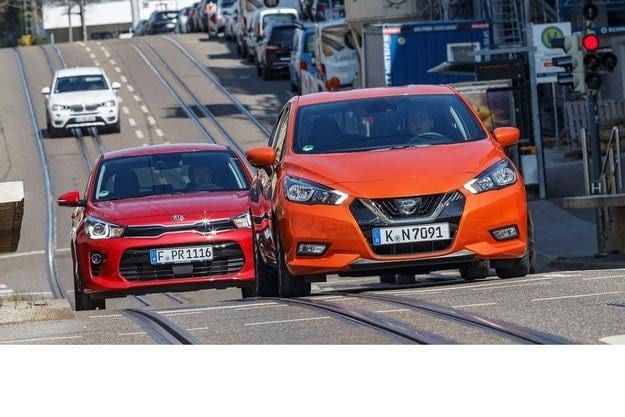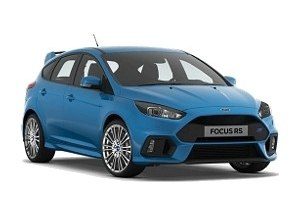
Test drive Kia Rio 1.0 T-GDI and Nissan Micra IG-T: good luck with the new engine

Extravagant Nissan Micra with a new trump card against the more functional compact hatchback Kia Rio
Nissan recently offered a small Micra with a 100 hp three-cylinder petrol turbo engine. In this comparison, we'll make it clear whether it can overtake the equally powerful Kia Rio 1.0 T-GDI.
“Radical micromorphosis” was the artistic statement the people of Nissan made to accompany the market debut of the fifth-generation Micra in early 2017. And rightly so, because the modest wildflower has evolved into a small car of expressive form that offered a lot inside. new things. Only under the hood, almost nothing has changed. The most powerful engine was a tired and rather noisy 0,9-liter gasoline engine. Renault which despite its 90 hp. he failed to pay due attention to the outstanding subcompact.
In just five months, a new 100 hp three-cylinder petrol unit appeared. is designed to bring more dynamics - but even this turbocharged liter engine can't get you excited enough. True, the three-cylinder machine is quite quiet and without vibration, but it lacks traction both when starting off and at high speeds. The reason for the weak start is probably due to the fact that maximum torque is only reached at 2750 rpm.
But even over 3000 rpm without a diesel particulate filter is not ambitious. Although the Micra weighs only 1085 kilograms, it takes a long time to accelerate from standstill to 100 km / h - 11,3 seconds.
A more dynamic Kia needs a little more gas
Of course, in small cars, everything does not stop at tenths of a second, but the Kia Rio with the same power (0-100 km / h: 10,0 s) is much more fun to accelerate in everyday traffic or when overtaking on the road, even somewhat surprising. Credit for this goes to an equally small, slightly noisier three-cylinder, which, however, has its Newton meters at 1500 rpm and usually pulls more evenly and more powerfully. In addition, unlike Nissan's designers, Kia is relying on direct injection and adding a precision gearbox and even a gasoline particulate filter. This may partly justify the average fuel consumption in the test of 6,9 L / 100 km, which exceeds the already high 6,4 L for the Micra. In principle, however, both models prove that when driving more vigorously, smaller, forced-loaded engines become too voracious, even if the cars are so small.
By the way, both the comfortable driving Rio and the slightly bouncing Micra are not too stingy. With a length of about four meters, they can accommodate four to five passengers and accommodate a pleasant amount of luggage, the weight of which is not too limited. Both models can carry more than 460 kilograms and, with the backrest folded down, have a cargo volume of around 1000 liters. In particular, taller passengers can comfortably fit in the rear of the classic Kia. The rear seat isn't as big as the Nissan's, but it's well shaped and there's no shortage of headroom above it. Good results are slightly larger door pockets, overhead handles and a large drawer under the boot floor.
In the back of the Nissan, you sit tight
In this regard, the Micra, which does not have a movable boot floor, requires a lot more compromises.
The heavily sloped bottom edge of the side windows significantly limits the view for the driver and rear passengers, while the sloping roofline reduces headroom. So the padded back seat feels like a dark cave, although the Nissan model is slightly taller than the more spacious Kia.
In addition to tall doorknobs, it is difficult for little passengers to reach. Thus, we must state once again that a special form is often accompanied by functional deficiencies.
But Micra can also please - for example, with its cozy interior. The instrument panel, partly upholstered in light-coloured fabric (also available in orange), gives the same high-quality impression as the door inserts or knee padding on the center console. Nissan finally offers an advanced navigation and infotainment system (€490). Maps are really good, the home screen can be quickly customized by drag and drop, and traffic data is received in real time. In addition, mobile phones connect seamlessly via Apple CarPlay and Android Auto, and zooming in on the map is much easier than before.
Kia's interior is simple and solid
For its part, the gray-toned interior of Kia's test car is rather prosaic, and the touchscreen menus are rather dated. But that's not a reason to underestimate the DAB radio and reversing camera system on offer for 1090 euros. Smartphones integrate quickly, and Kia Connected Services provides traffic and other information free of charge for seven years.
Thus, we finally come to the same long warranty period for which Rio rewards more points. And because it's also cheaper, Kia's balanced model wins this comparison by a wide margin.
Text: Michael von Meidel
Photo: Ahim Hartmann
Home " Articles " Blanks » Kia Rio 1.0 T-GDI and Nissan Micra IG-T: good luck with the new engine
